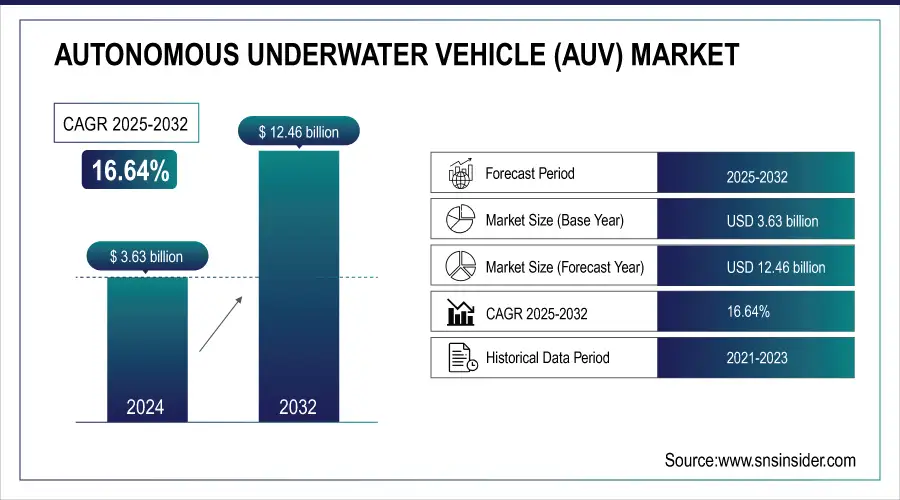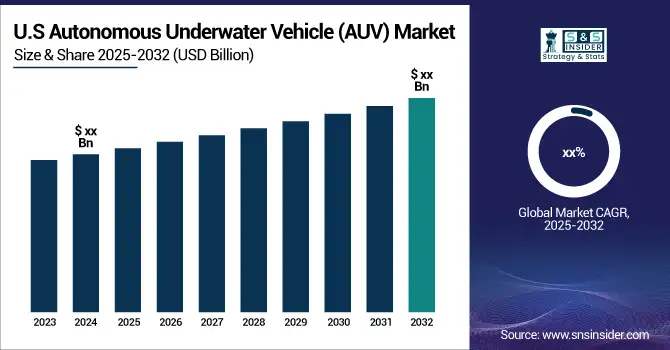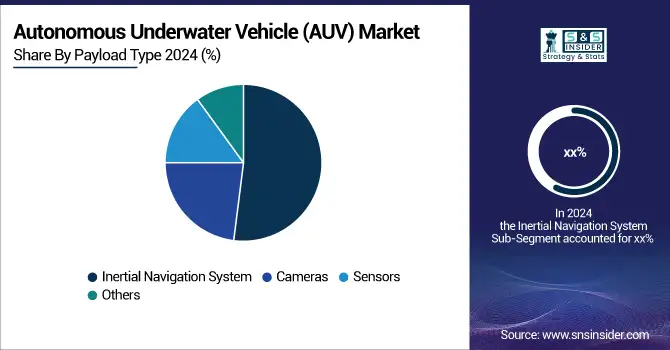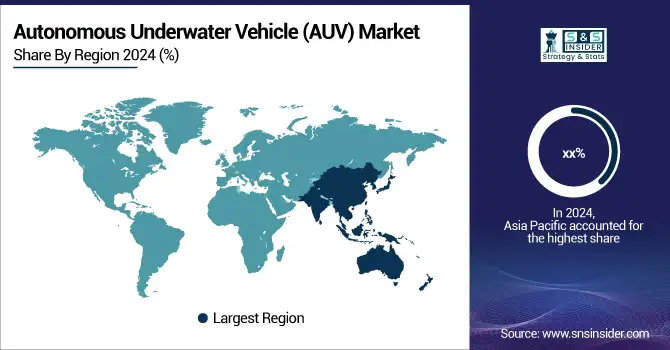Autonomous Underwater Vehicle (AUV) Market Size & Trends:
The Autonomous Underwater Vehicle (AUV) Market Size was valued at USD 3.63 Billion in 2024 and is expected to reach USD 12.46 Billion by 2032 and grow at a CAGR of 16.64% over the forecast period 2025-2032. The Autonomous Underwater Vehicle (AUV) Market is growing rapidly, driven by advancements in AI, navigation, and underwater communication. AUVs are essential for defense, oil & gas, oceanography, and environmental monitoring, supporting mine countermeasures, surveillance, and subsea inspections. Technological innovations in collision avoidance, imaging, and propulsion enhance efficiency, while government investments in defense and marine research fuel demand. AUVs aid sustainability efforts, deep-sea exploration, and climate studies.

To Get more information on Autonomous Underwater Vehicle (AUV) Market - Request Free Sample Report
With increasing public and private investments, advancements in battery technology and wireless communication are set to drive market expansion, boosting demand for cost-effective, high-performance AUVs in the coming years.

Autonomous Underwater Vehicle Market Size and Forecast:
-
Market Size (2024): USD 3.63 Billion
-
Market Size (2032): USD 12.46 Billion
-
CAGR (2025–2032): 16.64%
-
Base Year: 2025
-
Forecast Period: 2025–2032
-
Historical Data: 2021–2023
Key Highlights of the Autonomous Underwater Vehicle (AUV) Market
-
AI integration, advanced sensors, and wireless underwater communication enhance real-time decision-making, accuracy, and operational efficiency.
-
Government investments in naval surveillance, subsea inspections, and oceanographic studies are fueling adoption.
-
Expensive manufacturing, maintenance, and deep-sea repair logistics limit market penetration, particularly in emerging economies.
-
Growing use of AUVs for climate monitoring, coral reef studies, and marine ecosystem assessments creates new revenue streams.
-
Development of eco-friendly propulsion systems and energy-efficient AUV designs supports global sustainability initiatives.
-
Limited GPS access and bandwidth issues hinder real-time control and data transmission, restricting operational capabilities.
-
Cost-efficient production, modular designs, and AI-powered navigation systems are expected to overcome barriers and accelerate global adoption.
Autonomous Underwater Vehicle (AUV) Market Drivers
-
Advancements in AI, Sensor Technology, and Underwater Communication Driving Growth in the Autonomous Underwater Vehicle Market
The Autonomous Underwater Vehicle (AUV) market is experiencing significant growth due to advancements in artificial intelligence (AI), sensor technology, and underwater communication. AI-driven autonomy enhances real-time decision-making, improving AUV efficiency for applications such as defense surveillance, subsea inspections, and oceanographic research. Cutting-edge sensors, including high-resolution sonar and inertial navigation systems, improve data collection and operational accuracy. Meanwhile, wireless underwater communication technologies enable seamless data transmission, reducing dependency on costly tethered systems. These innovations make AUVs more effective in deep-sea exploration, oil & gas pipeline monitoring, and naval operations. As AI and sensor capabilities advance further, the market is expected to witness wider adoption across industries, reinforcing demand for smart autonomous underwater vehicles.
Autonomous Underwater Vehicle (AUV) Market Restraints
-
High Manufacturing and Maintenance Costs Restraining Market Expansion for Autonomous Underwater Vehicles
Despite growing demand, high manufacturing and maintenance costs pose a significant challenge to the widespread adoption of AUVs. Advanced AUVs require cutting-edge technologies such as AI-powered navigation, collision avoidance systems, and high-precision sensors, which drive up production costs. Additionally, maintenance expenses, including battery replacements, pressure-resistant materials, and software updates, contribute to overall operational costs. Many industries, particularly in emerging markets, hesitate to invest in AUVs due to these financial constraints. Smaller organizations and research institutes often struggle with the high upfront investment required to deploy AUV technology. Furthermore, repairs and servicing in deep-sea environments present logistical and financial challenges. These cost-related barriers limit market expansion, especially in budget-sensitive sectors, slowing adoption rates. To overcome this restraint, manufacturers must focus on cost-efficient production methods, improved battery life, and modular AUV designs that reduce long-term maintenance costs and enhance affordability.
Autonomous Underwater Vehicle (AUV) Market Opportunties
-
Increasing Demand for AUVs in Climate Change Research and Marine Biodiversity Studies Presents Growth Opportunities
The rising focus on climate change research and marine biodiversity conservation is creating new growth opportunities for Autonomous Underwater Vehicles (AUVs). Governments, research institutions, and environmental agencies are investing in AUVs for ocean monitoring, deep-sea exploration, and ecosystem assessments. AUVs enable researchers to track ocean temperature changes, study coral reef health, and observe deep-sea species without human intervention. With growing concerns over rising sea levels, ocean acidification, and biodiversity loss, AUVs offer a sustainable and efficient solution for long-term environmental monitoring. Additionally, advancements in eco-friendly propulsion systems and energy-efficient AUV designs support sustainability initiatives. The increasing availability of government funding and grants for marine research further accelerates adoption. As climate studies gain prominence, AUV manufacturers have a unique opportunity to develop specialized models tailored for environmental monitoring, thereby expanding their market presence in the research and sustainability sectors.
Autonomous Underwater Vehicle (AUV) Market Segments Analysis
By Payload Type
The Inertial Navigation System (INS) segment held the largest revenue share in the Autonomous Underwater Vehicle (AUV) market in 2024, driven by the increasing demand for accurate underwater positioning and navigation. Since GPS signals cannot penetrate underwater environments, AUVs rely on INS technology, which combines accelerometers, gyroscopes, and magnetometers to maintain precise navigation without external references. Leading companies are actively developing advanced INS solutions to enhance AUV capabilities. In 2023, Teledyne Marine introduced an upgraded version of its TSS Inertial Navigation System, improving real-time tracking for deep-sea operations. Similarly, Kongsberg Maritime launched a high-performance INS system for military and commercial AUV applications, enhancing long-endurance missions.
The Cameras segment is expected to grow at the highest CAGR during the forecast period, driven by increasing demand for high-resolution imaging in AUVs. Modern underwater missions require detailed visual data for inspections, surveillance, and environmental research, pushing manufacturers to develop cutting-edge imaging technologies. Companies are launching advanced underwater cameras with AI-powered image processing and enhanced low-light performance. In 2023, Sonardyne International introduced a new generation of compact, high-resolution underwater cameras tailored for AUV integration, enabling real-time oceanographic and security surveillance. Blue Robotics also released an upgraded low-light underwater camera, improving deep-sea exploration capabilities.

By Shape
The torpedo-shaped Autonomous Underwater Vehicle (AUV) segment held the largest revenue share in 2024, driven by its hydrodynamic efficiency, high-speed capability, and extended operational range. Torpedo-shaped AUVs are widely used in defense, oil & gas, and oceanographic research due to their ability to cover long distances with minimal energy consumption. Leading companies have introduced cutting-edge torpedo-style AUVs to enhance mission capabilities. In 2023, Boeing expanded its Echo Voyager series, launching an upgraded version with enhanced endurance and AI-driven navigation for military reconnaissance. Similarly, Kongsberg Maritime introduced an advanced HUGIN Endurance AUV, designed for deep-sea exploration and long-duration seabed mapping.
These developments are crucial for mine countermeasures, underwater surveillance, and subsea infrastructure inspections, where torpedo AUVs provide superior maneuverability and operational range. Additionally, integration with AI-based autonomy, improved propulsion systems, and advanced sonar imaging is making torpedo-shaped AUVs more versatile, reinforcing their dominance in the rapidly expanding global AUV market.
By Application
The defense segment held the largest revenue share in the Autonomous Underwater Vehicle (AUV) market in 2024, driven by the increasing adoption of AUVs for naval surveillance, mine countermeasures (MCM), and anti-submarine warfare (ASW). Militaries worldwide are investing in autonomous underwater technologies to enhance maritime security and intelligence-gathering capabilities. Leading defense companies are actively developing and deploying next-generation torpedo-shaped AUVs for underwater reconnaissance. In 2023, BAE Systems introduced an advanced Talisman AUV, designed for covert naval operations and underwater mine detection. Similarly, L3Harris Technologies launched an upgraded version of the Iver4 AUV, featuring AI-powered autonomous navigation and real-time data transmission for deep-sea military missions. These advancements are critical for modern naval forces seeking unmanned, cost-effective, and high-endurance underwater solutions.
The scientific research segment is projected to grow at the highest CAGR in the forecasted period, driven by the increasing need for deep-sea exploration, climate change studies, and oceanographic research. AUVs play a crucial role in mapping the seafloor, studying marine ecosystems, and monitoring environmental changes, as they provide unmanned, long-duration underwater data collection capabilities. Research institutions and oceanographic agencies are investing in advanced AUVs with high-precision sensors and imaging systems. In 2023, Fugro launched the Blue Essence AUV, designed for seabed mapping and geological surveys. Likewise, Hydromea introduced the Exray AUV, featuring swarm robotics technology for real-time underwater research applications. These innovations are vital for marine biodiversity assessments, underwater archaeology, and polar ice studies, as they offer cost-effective, high-resolution ocean monitoring.
AUV (Autonomous Underwater Vehicle) Market Regional Analysis:
Asia Pacific Dominance in the Autonomous Underwater Vehicle Market
The Asia Pacific region led the Autonomous Underwater Vehicle (AUV) market in 2024, accounting for a significant market share due to rising defense investments, increasing underwater exploration activities, and advancements in marine research. Countries like China, India, Japan, and South Korea are actively deploying AUVs for naval surveillance, deep-sea mining, and offshore energy sector applications. China has been rapidly expanding its unmanned underwater capabilities, with developments such as the Haiyan AUV, designed for long-endurance reconnaissance and oceanographic studies. Similarly, India's DRDO (Defence Research and Development Organisation) has been working on indigenous AUV technologies for coastal defense and underwater mine detection. The growth in offshore oil & gas activities, along with increasing government initiatives for marine biodiversity and climate change research, has further strengthened the region’s dominance in the market.

Get Customized Report as per Your Business Requirement - Enquiry Now
North America Emerges as the Fastest-Growing AUV Market
The North American region is the fastest-growing market for Autonomous Underwater Vehicles (AUVs) in 2024, with an estimated high CAGR, driven by strong defense funding, rapid technological innovation, and increasing commercial applications. The U.S. Navy has been aggressively investing in unmanned maritime systems, with major contracts awarded to companies like Boeing, Lockheed Martin, and General Dynamics for advanced AUVs such as the Orca XLUUV (Extra Large Unmanned Underwater Vehicle). Additionally, the growing offshore wind energy sector in the United States and Canada is fueling demand for AUVs in seabed mapping, subsea infrastructure inspections, and marine environmental assessments. Furthermore, organizations like NOAA (National Oceanic and Atmospheric Administration) are increasingly utilizing AUVs for deep-sea exploration and climate research. With strong government and private sector investments, along with ongoing innovation in AI-driven autonomy, advanced sensors, and long-endurance propulsion, North America is positioned as the fastest-growing region in the AUV market.
Europe’s Strategic Role in the AUV Market
Europe held a significant market share in the Autonomous Underwater Vehicle market in 2024, driven by increasing defense modernization programs, offshore renewable energy projects, and environmental monitoring initiatives. Countries like the United Kingdom, Norway, and Germany are key contributors, leveraging AUVs for offshore wind farm inspections, subsea infrastructure monitoring, and marine habitat conservation. The European Union’s emphasis on sustainable blue economy initiatives and investments in advanced maritime robotics has further propelled market growth in the region.
Latin America’s Emerging AUV Market
Latin America represented a growing market for AUVs in 2024, with increasing adoption in offshore oil and gas exploration, particularly in Brazil and Mexico. The expansion of deep-sea drilling projects and rising interest in marine biodiversity studies are fueling demand. Additionally, partnerships with international defense and marine research organizations are facilitating the deployment of AUVs for coastal security, underwater mine detection, and oceanographic research across the region.
Middle East & Africa (MEA) AUV Market Trends
The MEA region accounted for a smaller yet steadily expanding share of the Autonomous Underwater Vehicle market in 2024. Growth is driven by rising investments in offshore oil and gas, primarily in Saudi Arabia, the UAE, and South Africa, as well as initiatives for port security and maritime surveillance. Increasing focus on underwater archaeology, environmental monitoring in the Red Sea and Arabian Gulf, and strategic naval programs are gradually shaping the region’s adoption of AUV technologies.
Key Autonomous Underwater Vehicle (AUV) Companies are:
-
Boeing
-
ECA Group
-
Graal Tech
-
Bluefin Robotics
-
Boston Engineering Corporation
-
Fugro
-
Hydromea
-
International Submarine Engineering
-
Kongsberg Gruppen
-
Saab Group
-
Ocean Infinity
-
Teledyne Technologies
-
L3Harris Technologies
-
iXblue
-
Subsea Tech
-
Marine Advanced Robotics
-
OceanServer Technology
-
Deep Ocean Engineering
AUV (Autonomous Underwater Vehicle) Market Competitve Landscape
BAE Systems is a leading global defense, aerospace, and security company with a strong presence in the autonomous systems and maritime technology markets. The company plays a key role in the Autonomous Underwater Vehicle (AUV) market, leveraging its expertise in naval systems, advanced sensors, and AI-driven platforms. BAE Systems develops cutting-edge underwater technologies for naval surveillance, mine detection, and oceanographic research, supporting defense modernization programs worldwide. With significant investments in innovation, strategic collaborations, and government defense contracts, BAE Systems continues to strengthen its market position. Its robust portfolio and focus on unmanned maritime solutions make it a critical player in the global AUV industry.
-
In November 2024, BAE Systems completed initial in-water trials of its Herne extra-large autonomous underwater vehicle (XLAUV), demonstrating capabilities in intelligence, surveillance, and reconnaissance missions.
Ocean Infinity, founded in 2017 and headquartered in Austin, Texas, and Southampton, UK, is a pioneering marine robotics company offering advanced robotic solutions for AUV and USV operations. The company operates the largest deep-water AUV fleet, including its “Infinity” fleet and ambitious “Armada” fleet of robotic surface vessels. Known for high-endurance, eco-friendly missions, Ocean Infinity develops cutting-edge AUV battery technology for multi-day deployments. Its platforms support diverse applications—from seabed mapping and offshore wind surveys to complex searches like MH370. With global remote control centres, Ocean Infinity is redefining scalable, sustainable, and efficient ocean exploration.
-
In January 2025, Ocean Infinity, a marine technology company, announced plans to deploy underwater drones to resume the search for Malaysia Airlines flight MH370, which disappeared almost 11 years ago.
| Report Attributes | Details |
|---|---|
| Market Size in 2024 | USD 3.63 Billion |
| Market Size by 2032 | USD 12.46 Billion |
| CAGR | CAGR of 16.64 % From 2025 to 2032 |
| Base Year | 2025 |
| Forecast Period | 2025-2032 |
| Historical Data | 2021-2023 |
| Report Scope & Coverage | Market Size, Segments Analysis, Competitive Landscape, Regional Analysis, DROC & SWOT Analysis, Forecast Outlook |
| Key Segments | • By Type (Shallow AUVs [up to 100 m], Medium AUVs [up to 1,000 m], Large AUVs [>1,000 m]) • By Payload Type (Cameras, Sensors, Inertial Navigation System, Others) • By Shape (Torpedo, Streamlined Rectangular Style, Laminar Flow Body, Multi-hull Vehicle) • By Technology (Collision Avoidance, Navigation, Imaging, Communication, Propulsion) • By Application (Scientific Research, Defense, Oil & Gas Industry) |
| Regional Analysis/Coverage | North America (US, Canada, Mexico), Europe (Eastern Europe [Poland, Romania, Hungary, Turkey, Rest of Eastern Europe] Western Europe] Germany, France, UK, Italy, Spain, Netherlands, Switzerland, Austria, Rest of Western Europe]), Asia Pacific (China, India, Japan, South Korea, Vietnam, Singapore, Australia, Rest of Asia Pacific), Middle East & Africa (Middle East [UAE, Egypt, Saudi Arabia, Qatar, Rest of Middle East], Africa [Nigeria, South Africa, Rest of Africa], Latin America (Brazil, Argentina, Colombia, Rest of Latin America) |
| Company Profiles | Key players in the Autonomous Underwater Vehicle (AUV) Market are BAE Systems, Boeing, ECA Group, Graal Tech, Atlas Elektronik, Bluefin Robotics, Boston Engineering Corporation, Fugro, Hydromea, International Submarine Engineering, Kongsberg Gruppen, Saab Group, Ocean Infinity, Teledyne Technologies, L3Harris Technologies, iXblue, Subsea Tech, Marine Advanced Robotics, OceanServer Technology, and Deep Ocean Engineering. |

